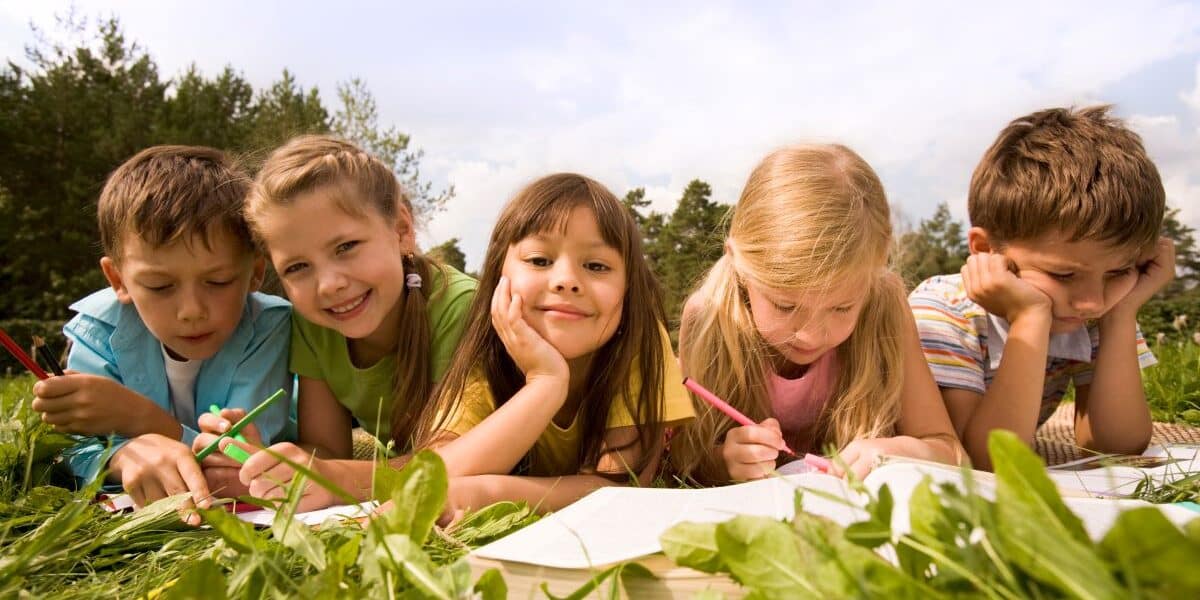For 15 years, the TurfMutt Foundation has advocated for the care and use of school yards, parks, backyards, and other green spaces.
These outdoor areas facilitate “backyarding,” the act of taking everyday activities that we normally do inside into the outdoor spaces around us, such as learning, studying, socializing, exercising, and more.
This not only makes life more enjoyable, but it also improves the health and well-being of children and the planet.
Over the years, we have seen the benefits to people, communities, and wildlife by having accessible green space to help balance our man-made environments.
The benefits of nature – which starts right outside our schools and homes – are vast. There is a wealth of scientific evidence to support the argument for growing our green space.
Here are the top six reasons we need more managed green space in our school yards and communities:
- Improved Learning
Studies indicate that children prefer school grounds with biodiverse vegetation over those that have more pavement.
Not only that, teaching outside can help students be more attentive to learning because children gain attention and working memory benefits when they are exposed to greenery. Trees on or near school grounds are positively linked to academic achievement in sixth-grade students.
Lastly, learning outside can help children develop important skills for future success in the workplace, including social skills and critical thinking abilities.
- Children’s Health
Children benefit from exposure to green space in several ways, including feeling better physically and mentally after spending time outside.
Surveys completed by 587 youth (age 11-14) in rural South Carolina showed that exposure and connection to nature were positively associated with growth in the five Cs of positive youth development (competence, connection, confidence, character, and caring).
Furthermore, a systematic review of six studies shows that even passive nature engagement (greenness around schools and in urban parks) has the potential to positively impact children’s attention capacity, mood and memory.
- Children’s Happiness
Spending time outside sparks joy in kids and improves their mental health. Children with more access to natural areas, as well as more perceived nature in the home and school environment, had lower stress levels, suggesting that nearby nature bolsters children´s resilience in dealing with stress.
A systematic review of current literature concluded that benefits associated with children’s access to green environments include improved confidence, social interactions, cognitive development, academic achievement, and emotional well-being.
Children’s stress levels fall within minutes of seeing green spaces, and even having window views to green landscapes help high schoolers recover from attention fatigue and stress.
- Environmental Benefits
Plants, shrubs, trees, and grass are “environmental superheroes” that capture and filter rainwater, produce oxygen, and absorb carbon.
The dense canopy and fibrous root system in a lawn sequesters carbon so well that it outweighs the carbon used for maintaining the grass by as much as seven-fold.
An average-sized home lawn in the U.S. has the potential to sequester 20.3 to 163.4 kg C/lawn/year. Planting trees results in less runoff and erosion, allowing more recharging of the ground water supply and resulting in less sediment and chemicals in streams.
- Financial Advantages
Having more green in our schoolyards can ultimately add more green to the school’s bank account.
According to the U.S. Forest Service’s Northern Research Station, the nation’s urban canopies, which are home to an estimated 5.5 billion trees, provide roughly $18 billion in annual benefits through the removal of pollution from the air ($5.4 billion), carbon sequestration ($4.8 billion), reduced emissions ($2.7 billion), and improved energy efficiency in buildings ($5.4 billion).
- Wildlife Corridors
Wildlife – including pollinating birds, butterflies, bees – have had to adapt to the human-made environment.
Having the proper green space that blooms throughout the year in school yards, backyards, and community parks plays a critical role in helping animals and insects thrive by reconnecting fragmented habitats into a connected ecosystem.
To find the best plants to support community wildlife in your area, consult the National Wildlife Federation’s Native Plant Finder.
Here’s an important note to school facility managers. Remember to practice the “right plant, right place” principle when greening your school yard.
This means selecting plants that support the needs of your teachers and students, as well as ones that will thrive in your climate zone with minimal work on your part.
Refer to the USDA’s Plant Hardiness Zone Map to find the plants, shrubs and trees that are best suited for your community.
Outdoor power equipment is as important for maintaining school yards as books are for teaching students. The right mowers, trimmers, edgers, blowers, pruners, chainsaws, and more can help you get the work done faster and can help safely maintain the green space at your school.
Always think safety first. Review the manufacturer’s safety guidance before starting up any equipment, and always keep children and pets away from machines during operation. Make sure your equipment is regularly maintained.
Protect your power by using only E10 or less fuel in gasoline-powered outdoor power equipment if it is not designed for higher ethanol blends. For battery-powered machines, only use the charger and batteries specified by the equipment manufacturer.
Kris Kiser is the president & chief executive officer of the TurfMutt Foundation, which encourages outdoor learning experiences, stewardship of our green spaces, and care for all living landscapes for the benefit of all, www.TurfMutt.com.















